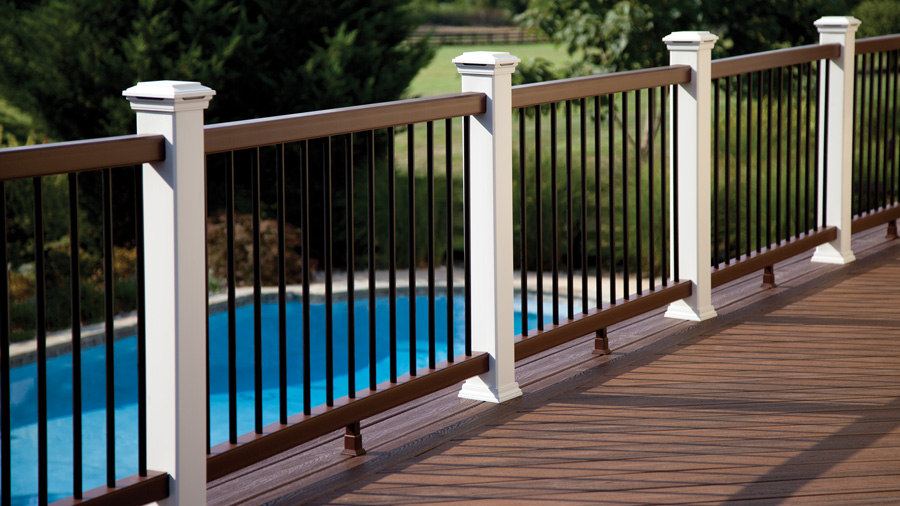Composite vs Wood Deck Cost & More
You're building or repairing a deck, and you feel like you're drowning in a sea of deck board options. You've seen great-looking photos of composite decks - but is the premium material worth the cost?
We help deck owners like you every day, simplifying deck material choices so you can make the best decision for your budget. Let's go beyond composite decking prices and take a look at the total cost of composite deck boards compared to other options on the market so you can make the most informed choice for your project!
Composite Decking Costs Examined
When you look at decks, there are two different types of cost to consider. There's You have composite decking prices, or the initial cost of the materials,. bBut there's also the long-term cost, because different decking materials weather at different speeds and regular varying levels of yearly maintenance costs. If you compare a composite vs wood deck, the differences can be startling.
Let's run through both types of costs when it comes to composite decking and the other top deck material options:
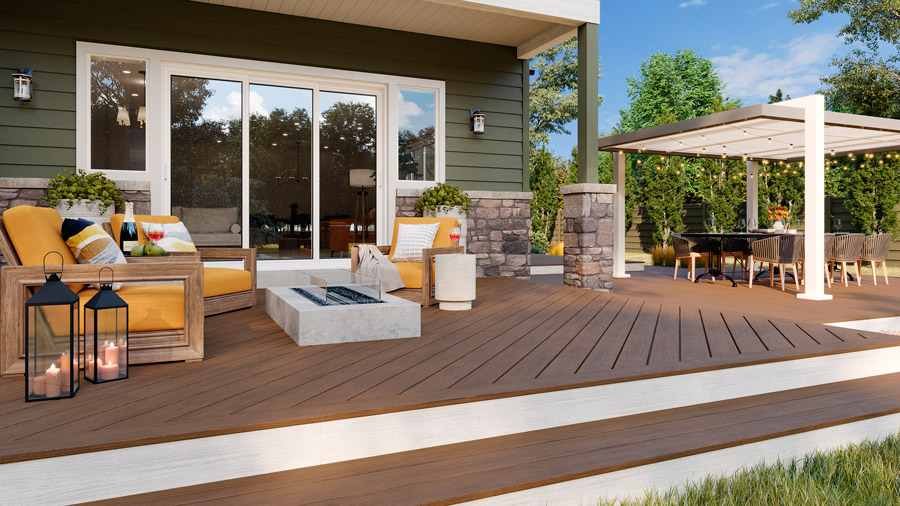
Initial Cost Comparison Between Different Decking Materials
Composite decking is a premium option - and that means paying a little more up front.
Initially, composite deck board prices will be a little more than luxury hardwood options like Ipe, and both will cost quite a bit more than your very basic pressure-treated wood boards. Here's a look at some estimated costs per square foot (though they're all highly dependent on where you buy and what type of board you buy in each category):
Estimated Costs For Different Decking Materials
Based on research from HomeAdvisor and Home Guide.
| Material | Estimated Cost Per Square Foot |
|---|---|
| Pressure-treated wood | $2 - $8 |
| Cedar | $4 - $8 |
| Ipe | $10 - $15 |
| PVC | $8 - $20 |
| Composite | $8 - $18 |
Long-Term Cost Comparison Between Different Decking Materials
The initial composite decking cost per square foot may be higher, but that's not the end of the story. Where composite decking really shines is in its low long-term costs. While you'll pay a little more up front to get composite boards, you'll save time and money over the life of the deck.
With wood decking (pressure-treated, cedar, or hardwood), you'll need to seal and/or stain your deck regularly - at least every few years, but ideally every year if you want to make your boards last as long as possible.
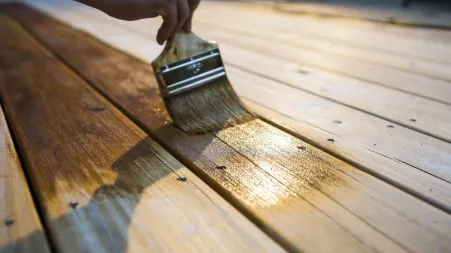
And that's just planned maintenance. Wood that's permanently outside and exposed to the elements will inevitably weather and begin to break down over time, even if you're diligent about staining and sealing it. Replacing rotted or splintering boards is another long-term cost - and an unpredictable one that always seems to pop up at the worst possible time.
Composite decking, on the other hand, never needs to be painted or stained. (Neither does PVC decking). It'll also weather the elements better, so you won't need to budget for emergency repairs, because composite decking doesn't rot, split, or splinter.
Initial Costs vs Long-Term Costs: Wood vs Composite Deck Example
To put some real numbers to our wood vs composite deck comparison, let's look at a fairly standard 16 x 20 deck - that's 320 square feet.
We've used numbers right in the middle of the HomeAdvisor/Home Guide estimate ranges above:
- Estimated material costs: $5 per square foot for wood and $13 per square foot for composite
- Estimated labor costs: $12 per square foot for either material
- Estimates don't include fasteners or other features like framing or railing
- Estimated maintenance costs: staining ($3 per square foot) and sealing ($2 per square foot), including labor and materials
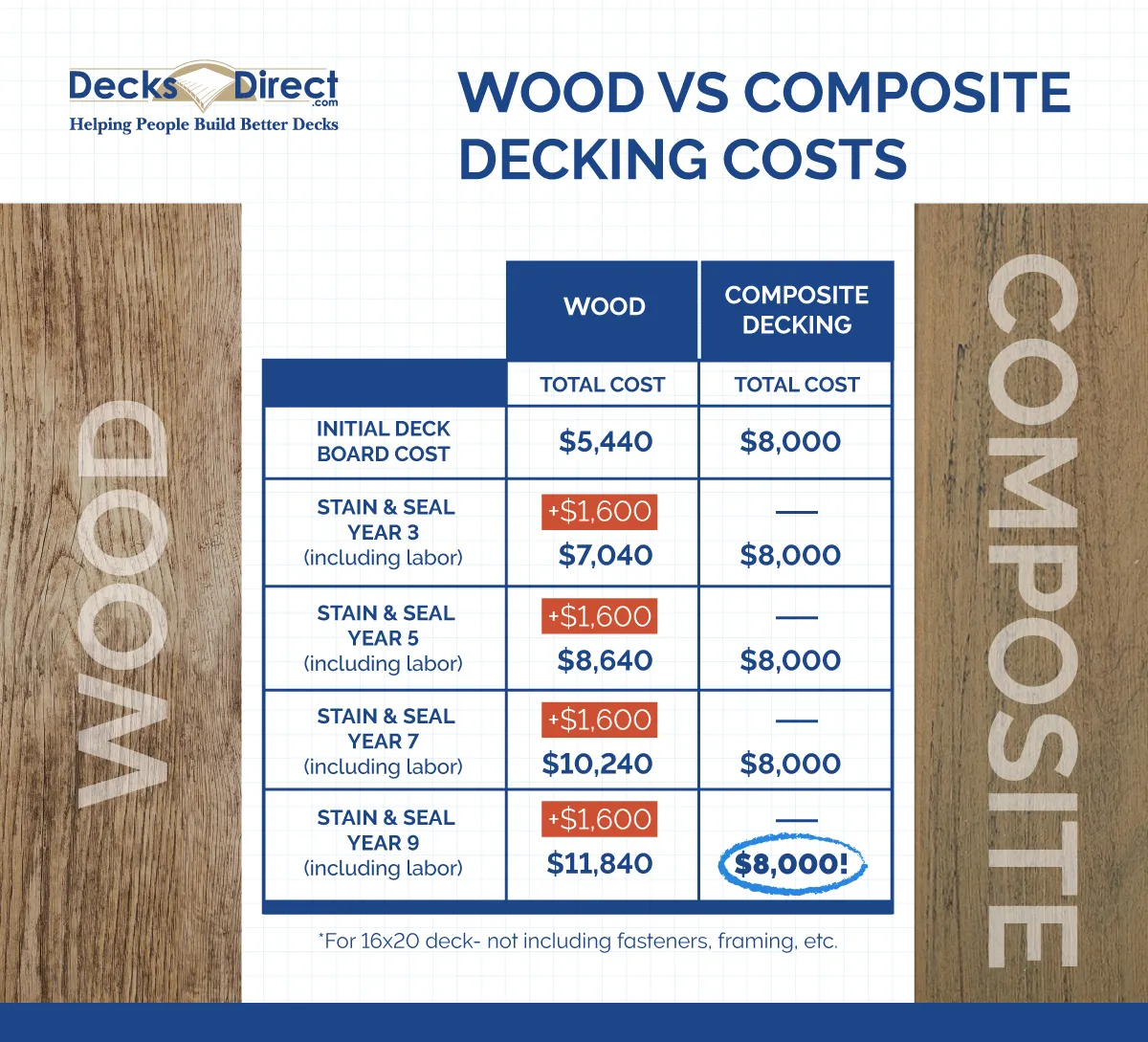
Note: the numbers above don't include fasteners or other features like framing or railing.
Based on these estimates, the wood deck is a few thousand dollars cheaper initially - no small margin. But you can see how quickly the regular maintenance costs add up. Within five years, the wood deck's total cost has already risen higher than the composite deck's total cost.
And by year 9, the wood deck's maintenance needs have pushed the total cost nearly $4,000 higher than the total cost of the composite deck - not to mention the time and effort saved in hiring out all that regular maintenance.
You could space out staining and sealing every three years instead of two (or choose to only stain or only seal), but that will also cut down on the long-term lifespan of your deck.
Ultimately, this composite deck vs wood cost comparison is why we highly recommend choosing composite or PVC deck boards if you plan to own the deck for more than a few years. A deck is a long-term investment, and it's worth doing it right to save money in the long run.
What Affects Composite Decking Prices?
Composite decking prices aren't set in stone - several factors come into play when figuring out the final cost of your project. From composite deck board prices to labor, knowing what influences pricing can help you budget smarter and make the best choices for your deck.
1. Deck Size
Bigger decks mean more materials, which naturally raises the cost.
2. Decking Material & Quality
Not all composite boards are the same, with a variety of pricing tiers to choose from. Budget-friendly options have a simpler finish, while premium boards come with deeper wood grain textures, multi-tone colors, and extra durability. Capped composite and PVC boards cost more upfront but hold up better against moisture, fading, and stains.
3. Design Complexity
A straightforward rectangle is the most cost-effective design. If you're adding curved edges, picture framing, multiple levels, or built-in seating, expect to pay more in both materials and labor. Custom patterns like herringbone or diagonal layouts also require extra boards and precise installation, increasing the total price.
4. Railings & Accessories
Railings can be a major cost factor, especially if you opt for aluminum, glass, or cable railings instead of traditional composite or wood. Post caps, fascia boards, and hidden fasteners also add to the total price, so it's worth considering which features are must-haves.
5. Labor & Installation
If you're hiring professionals, labor costs will depend on deck size, height, and complexity. A simple, ground-level deck is easier (and cheaper) to build than an elevated or multi-tiered design. While DIY installation can save money, professional installation ensures a precise build and compliance with local codes.
6. Site Prep & Permits
If your backyard needs grading, excavation, or additional foundation work, those costs add up. Some locations also require permits and inspections, so it's best to check local regulations before starting.
Understanding these factors helps you balance budget and design, ensuring you get a deck that fits your style and lasts for years to come.
Pros & Cons of Different Decking Materials
We weighed the costs above, but here's a really quick rundown of the pros and cons of some of the different decking materials so you can make the best decision for your specific home and deck:
Pressure-Treated Wood
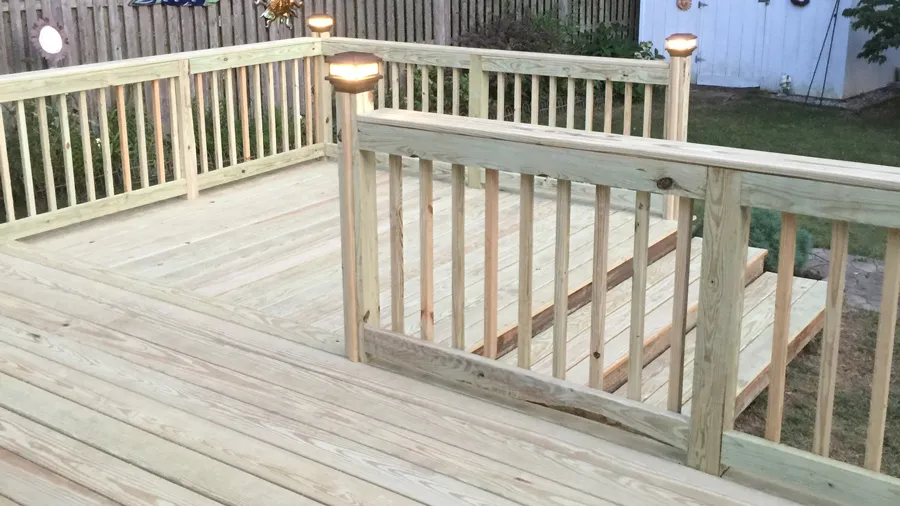
Pros:
- Lowest-cost
- Strong
- Traditional wood look
Cons:
- High-maintenance: requires staining or painting every 2-3 years, plus regular repairs
- Recurring stain & repair costs add up and eat into the initial cost savings
- Very limited look & style options
- Shorter lifespan
- Exposure to water causes mold, mildew, cracking, splitting or splintering
Cedar Decking
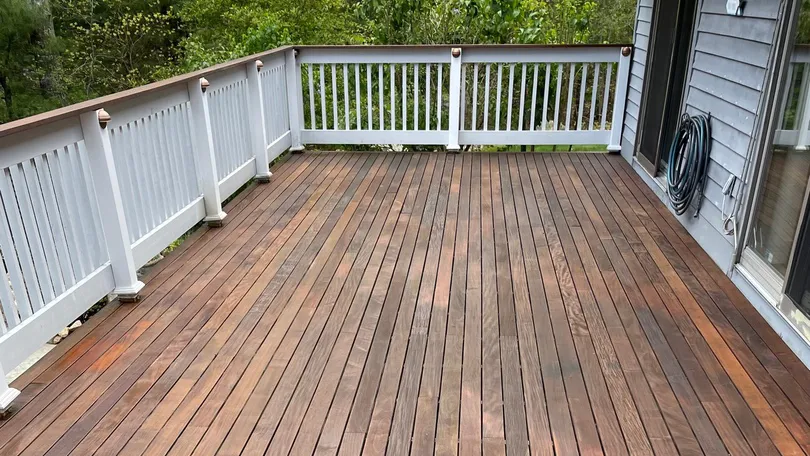
Pros:
- More durable & longer-lasting than pressure-treated wood
- Richer, more luxurious looks
Cons:
- Soft wood that scratches easily
- Still requires plenty of maintenance along with staining and sealing
- Doesn't last as long as composite or PVC decking, and water exposure causes mold, mildew, cracking or splintering
Composite Decking
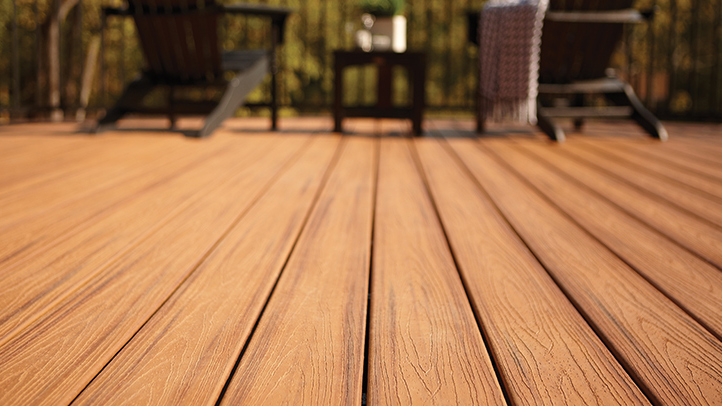
Pros:
- Tough capping resists mold, mildew and water damage
- Low-maintenance: never needs painting or staining
- Doesn't split, crack, splinter or rot
- Maintains its look, color and texture longer than wood
Cons:
- Costs more initially
- Can get hot in direct sunlight
PVC Decking
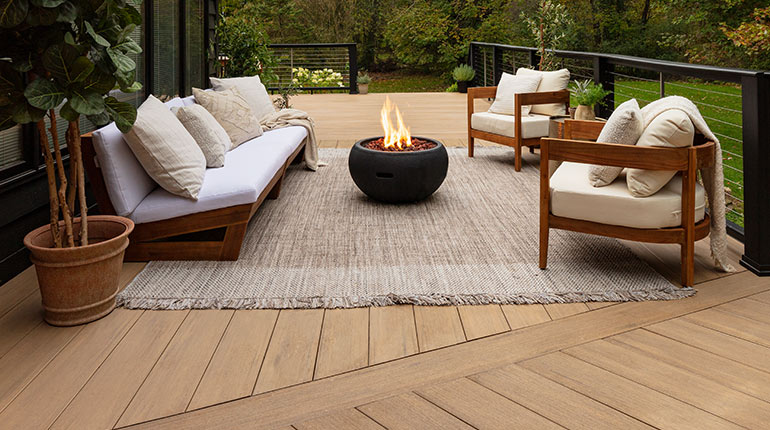
Pros:
- Complete resistance to water damage - no mold, mildew or rot
- Unaffected by termites and other wood-eating insects
- Most fire-safe decking
- Heats up slower and cools down faster than composite decking
Cons:
- Most expensive decking option
- Older PVC decking can look artificial, though modern PVC looks have improved dramatically
A Composite vs Wood Deck: What To Consider
Short-term and long-term costs are important considerations when comparing a composite vs wood deck. But there are other factors to look at, such as:
Versatility
Both wood and composite decking materials have high levels of versatility. However, in this case, composite decking gets the edge because of a few factors. First, most wooden planks are sold in lengths of 16 feet, while composite planks can come in lengths of 20 feet. This means that your deck will have fewer seams depending on its dimensions if you use composite. Additionally, composite decking can be secured using more varied application methods besides just screwing them down to your joists. Most manufacturers have developed hidden fastener, clip, or plug systems that work perfectly with composite deck boards to deliver a deck surface unblemished by unsightly screwheads.
Environmental Factors
Decking is, by definition, designed to be capable of handling the elements. Deck boards are designed to be outside for their entire lifetime, after all! That being said, there are some differences in environmental factors to consider. Wooden boards tend to be more susceptible to climate differences: wood tends to swell and shrink when exposed to changes in temperature and humidity. Composite decking shows much less expansion and contraction, and mineral-based composites are designed to feature almost no thermal expansion or contraction. This makes composite decking materials a better choice for four-season decking.
Other things to consider when it comes to environmental factors include things like resistance to damage through mold, fungi, mildew, algae, scratches, and even fire. Composite decking resists mold, mildew and other water damage much better than traditional wood does. (Fully-synthetic PVC decking offers the best water resistance on the market). Composites are also safer from fire - in fact, many composite deck boards are certified as Class B for flame spread, an important consideration for decks in areas prone to wildfires.
Safety
Safety is always important when it comes to your choice of decking material, not just for yourself but for your family. If you have young children, for example, you want to ensure your decking choice isn’t going to place your kids or your pets at risk if they walk on it. The most common safety issue with wooden decks is often splintering, which can lead to painful, punctured feet for pets, children, and adults. Thankfully, splinters can be prevented by keeping your deck sanded periodically. Meanwhile, composite decking doesn’t splinter like wood decking, so there’s no need to inspect or sand down your deck boards to keep bare feet safe.
Eco-Friendliness
If being ecologically savvy is important to you, composite decking is the clear winner. Composite decking is routinely made with recycled materials, reusing plastics that would otherwise end up in landfills. Wood decking, meanwhile, contributes to deforestation as the lumber industry cuts down trees to treat and process into decking material.
How Much Does Composite Decking Cost? - Brand Comparison
Within the spectrum of composite decking, you can find a lot of variation in price, too. Composite deck prices differ, depending on the brand and line. So if you're looking to get the benefits of low-maintenance composite without changing your target budget, you can use this guide to help find the boards for you:
| Brand | Cost Range |
|---|---|
| Trex | $ - $$$$ |
| TimberTech | $ - $$$$ |
| Fiberon | $ - $$$ |
| Deckorators | $$$ - $$$$ |
| Barrette Outdoor Living | $ - $$ |
| Envision | $ - $$ |
Trex Decking: Proven & Accessible
Trex offers advantages like:
- #1 name in composite decking
- Proven, traditional styles
- Accessible anywhere: fully in-stock with nationwide shipping from DecksDirect
- Lots of same-brand railing, lighting, and underdecking options
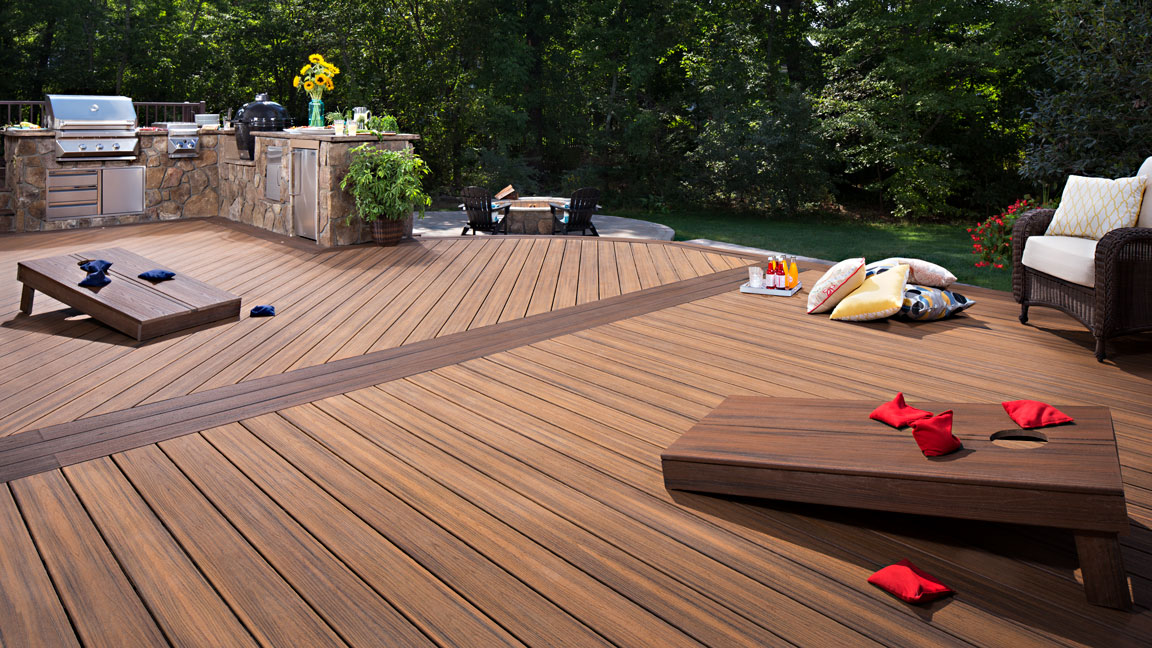
Trex is the first and biggest name in composite decking, with classic, proven looks and three different tiers of deck boards that span a range of budgets. The brand remains a giant in the outdoor living space because its products are rock-solid reliable - they hold up for decades in any weather and climate.
Decking Lines Available:
- Trex Transcend Lineage (premium - $$$$)
- Trex Transcend (best - $$$)
- Trex Select (best - $$)
- Trex Enhance (good - $)
TimberTech Decking: Desirable & On-Trend
Learn more about TimberTech decking
With TimberTech, you get:
- Detailed, on-trend looks
- A favorite of contractors and decking professionals
- Huge range of product offerings
- Multi-width deck board offerings
- Premium PVC offerings
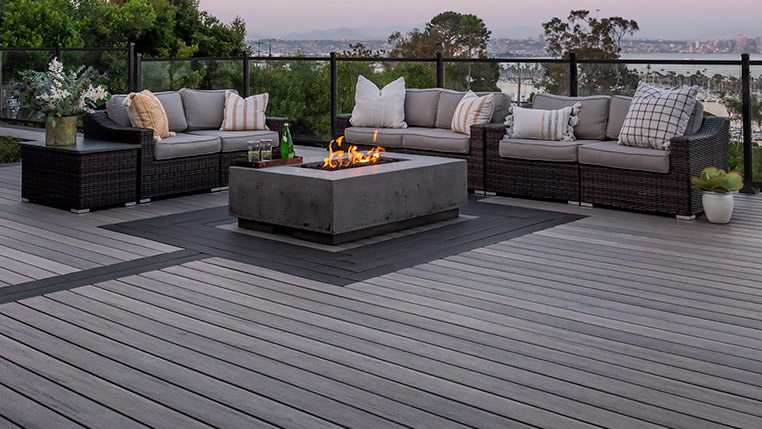
TimberTech is another huge outdoor living brand, and they've become well-known for the most beautiful, eye-catching low-maintenance deck boards on the market. TimberTech has a huge range of decking lines and offers both PVC and composite options.
Decking Lines Available:
- TimberTech Advanced PVC Decking Boards (best)
- TimberTech Advanced PVC Vintage (premium - $$$$)
- TimberTech Advanced PVC Landmark (Best - $$$)
- TimberTech Advanced PVC Harvest (good - $$)
- TimberTech Composite Decking Boards (better)
- TimberTech Composite Legacy (premium - $$$$)
- TimberTech Composite Reserve (better - $$)
- TimberTech Composite Terrain (good - $)
Fiberon Decking: High-Value & Sustainable
Learn more about Fiberon decking
Fiberon benefits include:
- 4-sided capping and graining options
- Eco-friendly, sustainable, efficient production processes
- Expert-inspired and expert-approved products
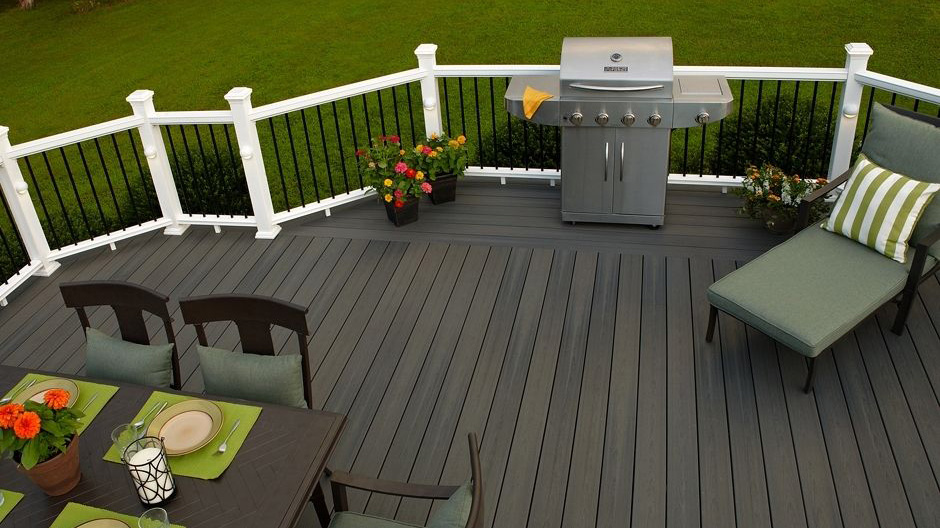
Fiberon's big calling card is its Concordia line, which features 4-sided capping plus natural wood graining on all four sides of each board. That makes it ideal for two-level decks, so you see a beautiful wood finish on the underside of each board, rather than a flat, ungrained surface. Fiberon's color palette is also a little richer than most composite boards, and the look is undeniably classy.
Decking Lines Available:
- Fiberon Concordia (best - $$$)
- Fiberon Good Life (good - $)
Deckorators Decking: Premium & Innovative
Learn more about Deckorators decking
Deckorators offers advantages such as:
- Premium, luxurious deck looks
- The newest and best technology: mineral-based composite
- On-trend color mixes and multi-tonal looks
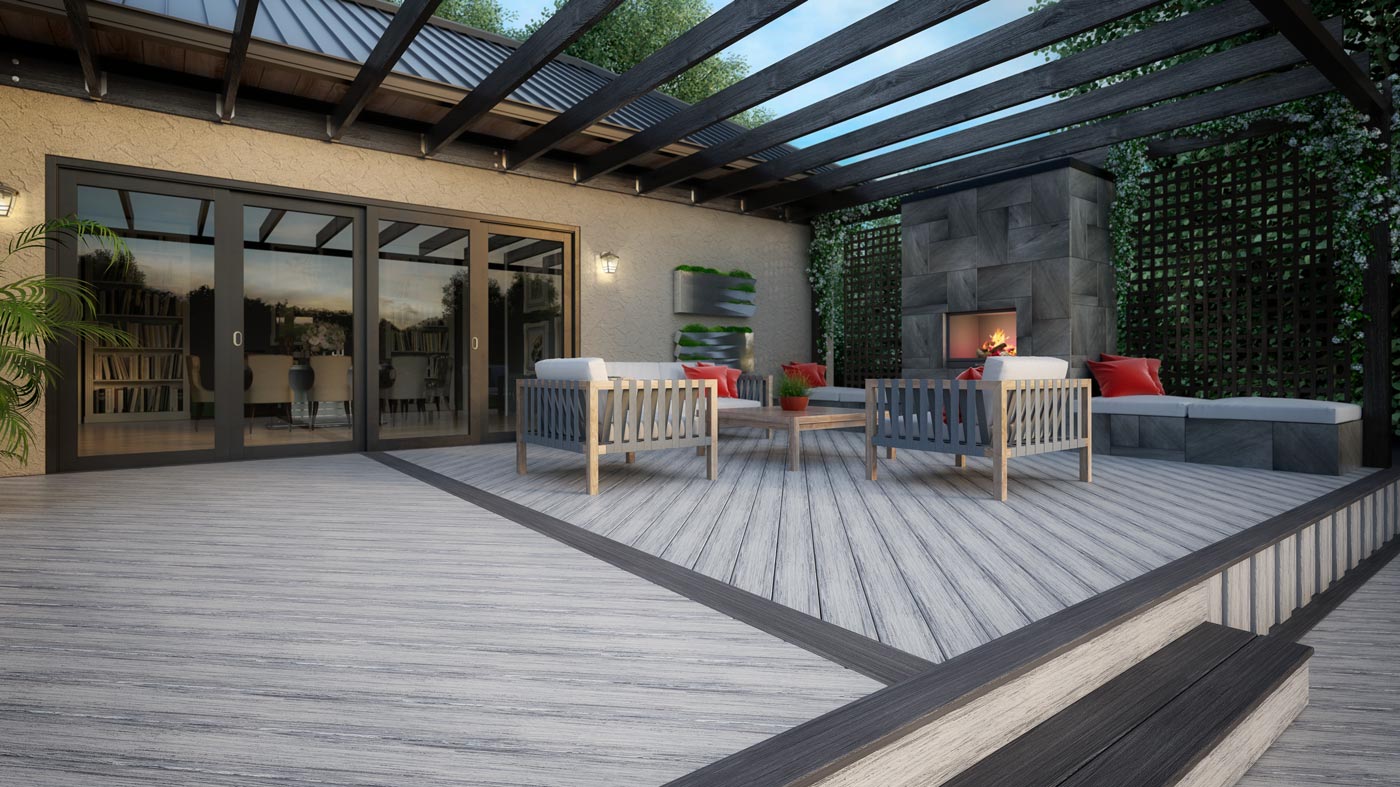
Deckorators is a pioneer in the space, launching a brand-new material: mineral-based composite. Mineral-based boards replace the wood fibers in traditional wood-plastic composites with durable minerals that make the boards more stable and longer-lasting. Deckorators boards also look luxurious and high-end.
Decking Lines Available:
- Deckorators Voyage (premium - $$$$)
- Deckorators Vault (best - $$$)
Barrette Decking: Distinctive & Unique
Learn more about Barrette Outdoor Living decking
Barrette benefits include:
- Incredibly unique decking looks - each board looks one-of-a-kind
- Unique and innovative “step clip” fastening method
- Lots of color variation within each board
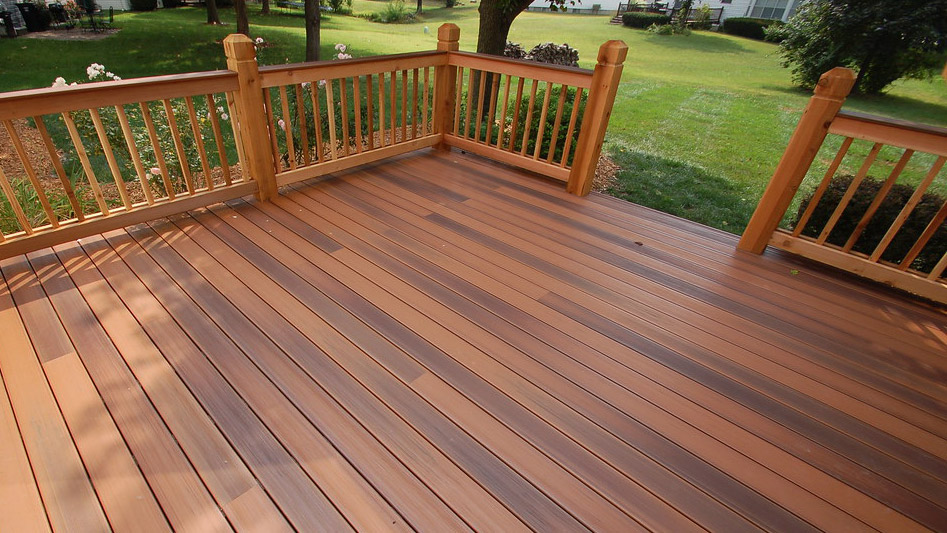
Barrette Outdoor Living deck boards have a totally distinctive look - the color varies from board to board and even from one end of each board to the other. The result is an eye-catching deck like the one above. If you love the look, Barrette is perfect for you, and it's also on the less-expensive end of composite decking brands.
Decking Lines Available:
- Barrette Siesta (better - $$)
- Barrette MVP (good - $)
Envision Decking: Versatile & Cost-Effective
Learn more about Envision decking
- High-quality deck boards at entry-level price points
- Wood grain patterns never repeat
- Classic, traditional deck looks
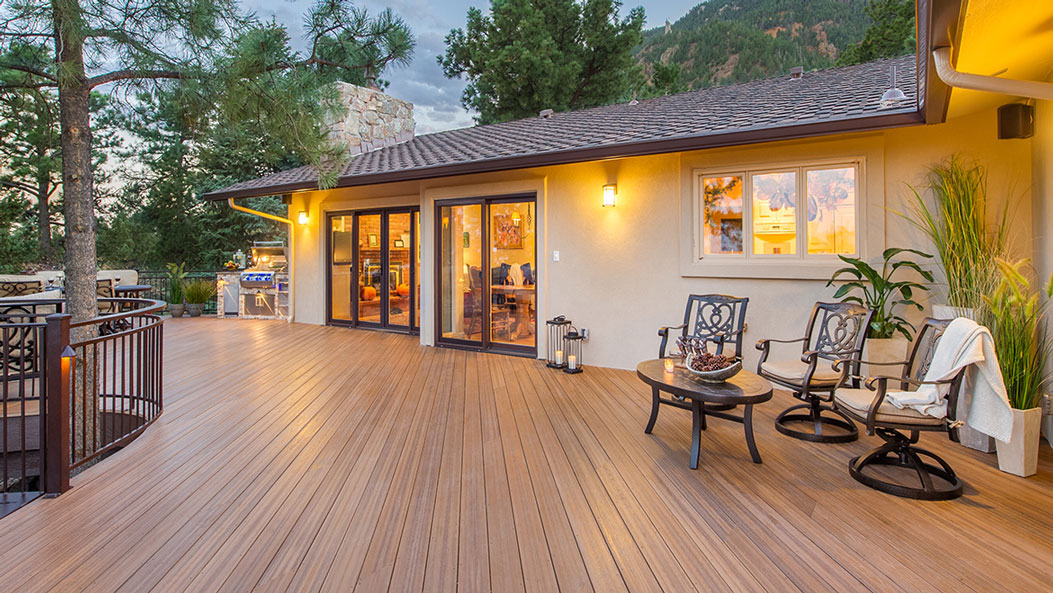
Envision decking is perfect for deck owners who want all the low-maintenance benefits of composite without paying a premium price. The boards look and perform great, and the price point is very attractive for builders on a budget.
Decking Lines Available:
- Envision Distinction (better - $$)
- Envision Expression (good - $)
- Envision Ridge Premium (good - $)
Cost-Saving Option: Scalloped-Bottom Composite Deck Boards
If you're looking for a lower-cost composite decking option, look for boards with a scalloped bottom. Most brands offer a scalloped option, like Trex's Enhance boards, shown below:
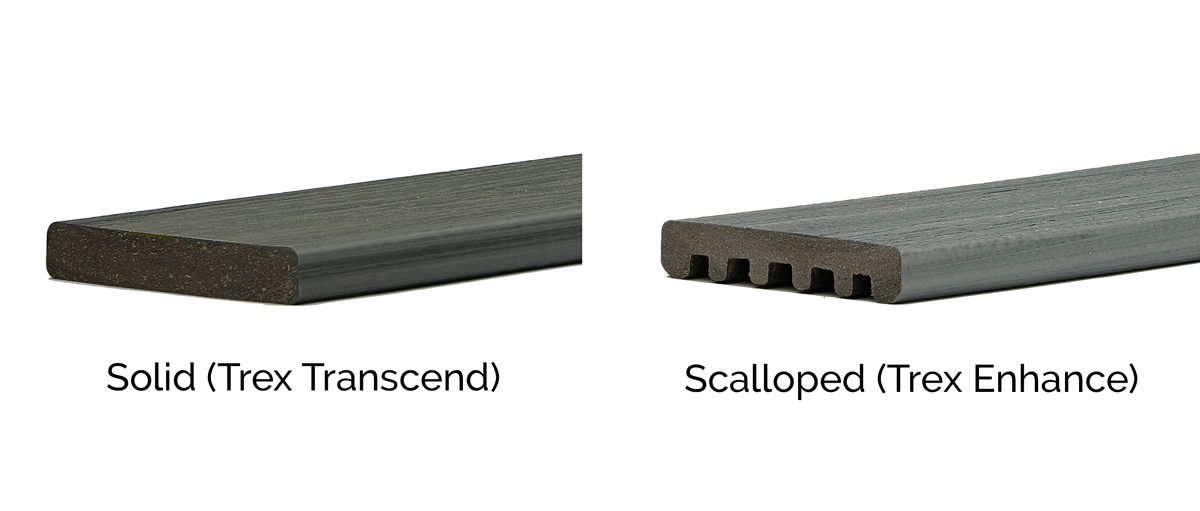
Scalloped boards use less composite material to keep the cost low. And once they're installed, you won't even notice the difference, because the scalloped bottoms are hidden beneath the deck:
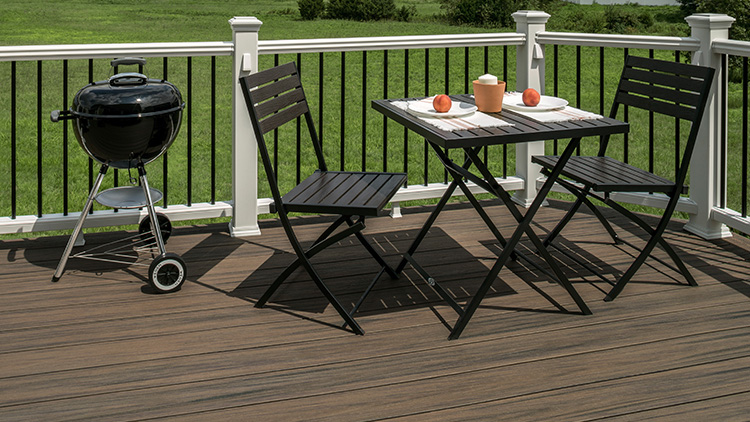
Composite Decking: Is It Worth The Cost?
Our decking pros believe the answer is a resounding "yes".
At DecksDirect, our team of project planners helps thousands of deck owners every year with planning, upgrading, and maintaining their decks. Some customers are building brand new decks, but most of them are repairing or updating decks that are anywhere from a few years to a few decades old.
Working with that many decks across their lifespans, we see the huge importance of low-maintenance and long-lasting materials. Maintenance and repair costs add up quickly. Decks are meant to be enjoyed for decades - so we believe they should be built to last decades, too.
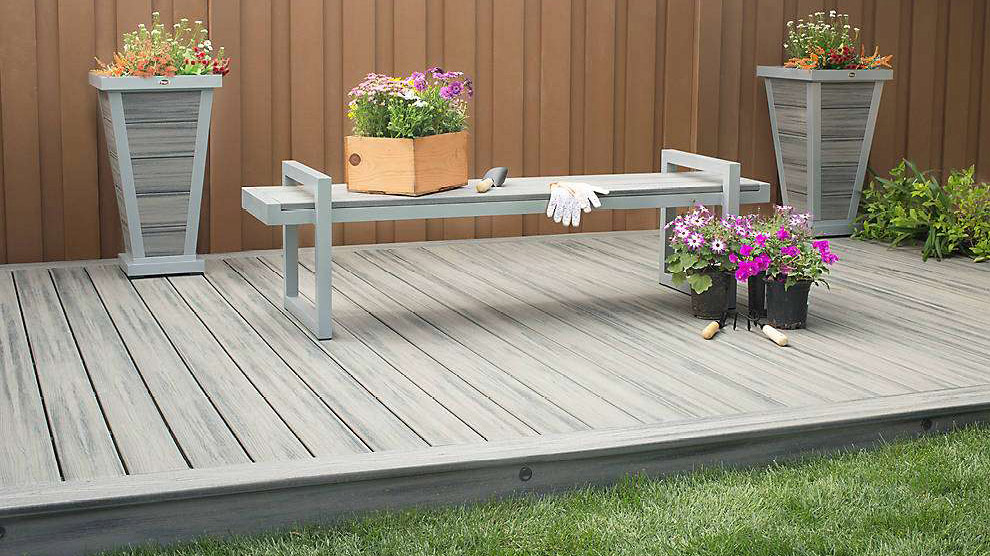
That's why we highly recommend choosing a low-maintenance composite or PVC deck board option. You'll get a better-looking, more durable deck - and within a few years, the more expensive deck boards will pay for themselves in saved maintenance costs.
Not to mention the time and sweat you'll save by never having to stain or seal your deck again.
When you look beyond the initial composite decking prices, it's a decision that makes sense. If you're interested in planning a low-maintenance composite deck, check out our online options. Happy decking!
Frequently Asked Questions About Composite Decking Prices
The $4.1 billion North American deck market can be confusing, but DecksDirect has the information you're looking for. Here are some common questions we receive.
Why do some composite decking brands cost more than others?
Higher-end composite decking brands offer more durable materials, better color retention, and deeper wood grain textures. Capped composite and PVC decking tend to be more expensive because they resist stains, moisture, and fading better than budget-friendly options. Some brands also offer longer warranties, which can add to the price.
Can I save money by installing composite decking myself?
Yes! If you're comfortable with DIY projects, installing composite decking yourself can save thousands in labor costs. However, professional installation ensures proper spacing, secure fastening, and a smooth finish. If your deck design is complex or elevated, hiring a pro might be worth the extra expense.
Does composite decking increase home value?
Yes! Composite decking adds curb appeal and is a major selling point for homebuyers looking for a low-maintenance outdoor space. While it may not recoup 100% of the investment, it can significantly boost property value and attract buyers who appreciate long-lasting, high-quality materials.
Knowledge Center
Tips and tricks on deck building and designing from the experts here at DecksDirect!




